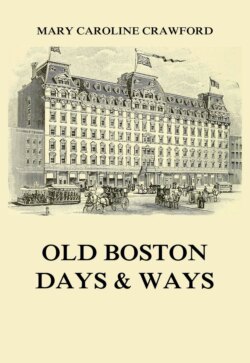Читать книгу Old Boston Days & Ways - Mary Caroline Crawford - Страница 4
На сайте Литреса книга снята с продажи.
FOREWORD
ОглавлениеAlmost of necessity a town is a different thing, and has a social life quite distinct, from a city. On its political side it is endowed with color and individuality, from the very fact that its humblest inhabitant may, at town meeting, raise his voice to oppose the motion of the richest and most renowned man in the community. And, on the social side, it possesses a simplicity of interests, a delightful neighborliness, and a quality of charming intimacy which may never be claimed by a city.
So, in this book, — which takes up where my "St. Botolph's Town" dropped it, the story of Boston's share in the struggle for independence, — I have stopped just short of the time when we blossomed into a municipality and indulged in a mayor and aldermen.
The end of Boston's life as a town seemed to me really the end of an era and I thought I could paint a better picture of life and manners here, during the period which followed the Revolution, if I did not venture far into the history of the nineteenth century.
Besides, the niche that I have endeavored to fill in this book has been curiously vacant heretofore. No single volume happens to have covered intensively, so to speak, that very interesting formative period when the peculiar genius of Boston was beginning to find itself in art, in politics, and in civic life. Characteristically, I have passed lightly over the politics and have dealt with the personal rather than with the technical side of the arts. I am so incorrigibly of the opinion that the people of a period are its history!
My warm thanks are due to the Houghton Mifflin Company for their courtesy in permitting the quotations credited to Mr. James K. Hosmer's "Life of Samuel Adams," and to Mr. Harold Murdock's "Earl Percy's Dinner Table"; thanks I give also to Mr. Howard W. Spurr for his kindness in allowing extracts from Goss's "Life of Paul Revere," to Mr. Charles Knowles Bolton, of the Boston Athenaeum, for his personal helpfulness and for his generous permission to draw upon the rich illustrative material in the possession of the library, to Mr. Louis A. Holman, to Mrs. James A. Garland, who has helped me greatly in the Tudor data and pictures, to Mr. William Sumner Appleton, who has cooperated to the end that the lovely portrait of Mrs. Richard Derby might appear in the book, to Mr. William B. Clarke, for his service in connection with Revere's lantern-hanger, and to the New England Magazine, whose publishers have kindly placed at my disposal a wealth of rare information about old Boston.
The works which have been consulted in the preparation of this volume are many more than could be named here, and credit to them is, for the most part, given in the text. But my debt to the invaluable "Memorial History of Boston" is so great that I must acknowledge it here as well as there. I heartily thank also the many custodians and collectors who have helped me in my browsings among those contemporary newspapers and documents, without which no history of this period could be written, but for which, lacking the kindly aid of specialists, one would so often search libraries and bookshops in vain. m. c. c.
Charlestown, Massachusetts, 1909.
